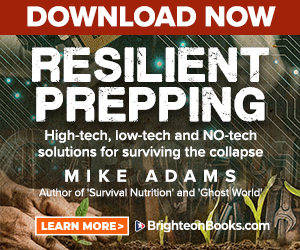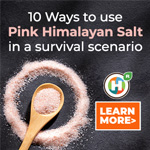
How to increase iron in your diet
Saturday, February 12, 2011 by: Cindy Jones-Shoeman
Tags: dietary, iron, health news
- BEWARE: USDA allows genetically engineered vaccines to infiltrate organic food production
- LYME DISEASE on the RISE raising suspicion it's still part of U.S. military bioweapons program gaining traction for Lyme Disease PLANDEMIC
- Sodium-ion battery BREAKTHROUGH offers a faster, safer, and more sustainable revolution in energy storage
- Breaking the aging code: How diet shapes longevity from breakfast onward
- Is Del Bigtree leaving MAHA? Bigtree blasts the MAHA report's shocking silence on vaccine failure and vaccine injury
- Pat McGrady Sr. reveals DMSO’s medical potential and the story of its persecution
- Poll: Overwhelming majority of Americans demand Big Pharma ACCOUNTABILITY for vaccine injuries
- Methylene blue’s remarkable potential for neuroprotection and beyond
- Trump's tariffs REINSTATED: Judicial tug-of-war exposes deep rift in America's trade policy
- Supreme Court curbs judicial overreach on NEPA reviews, backs infrastructure projects
- Holistic eye care and ancient practices challenge surgery’s reign in cataract treatment
- Trump Admin yanks $700 MILLION in funding from Moderna, staving off another deadly mRNA jab and a combo H5N1/flu shot stab
- Trump orders federal hiring overhaul, replacing DEI with merit-based system
- Trade truce in danger as Trump accuses China of violating deal, talks hit roadblock
- Revolutionizing health: The enduring impact of Murray and Pizzorno’s “Encyclopedia of Natural Medicine”
- Israel accepts U.S.-brokered Gaza ceasefire, but Hamas rejects terms as insufficient for lasting peace
- LexisNexis DATA BREACH showcases security risks of corporate data warehouses
- Antifa attacks Christians in Seattle: FBI investigates “targeted violence” amid free speech clashes
- Globalists call for “celebration” of plunging human fertility as war against humanity accelerates
- HEALTH SECRETS: How to Instantly Block MSG Toxicity Using Natural Substances (and the secret of Methylene Blue)
- The 20 deadliest sugar-loaded foods and how to replace them before they kill you
- WAR ON COGNITION: The Coordinated Assault on Your Brain and How to Defend Yourself Against Every Attack
- WHO Pandemic Treaty sparks sovereignty concerns amid secretive voting and U.S. withdrawal
- Toxicologist reveals four simple ways to slash microplastics in your drinking water
- Amazing microscopy photos reveal how freezing crystals attempt to mimic electronic structures they are touching
- Trump signs controversial Take It Down Act amid concerns of censorship and government overreach
- MSG EXPOSED: Hidden Neurotoxins Found in Groceries, Snacks and Popular Fast Food Menus
- RED ALERT: Nuclear War Between India and Pakistan Could Trigger Global Catastrophe… full RISK ANALYSIS
- An inexpensive and forgotten superfood: BEANS are key to reversing chronic disease
- This overlooked class of food additives is linked to Crohn's disease and cancer
- Vitamin C: A potential game-changer in cancer treatment
- Biden administration targeted mask and vaccine opponents as "terrorists," new docs reveal
- The dark truth behind Ozempic and Wegovy: Big Pharma's profit-driven gamble with your health
- Hidden food chemicals in many “health” foods linked to gut damage, cancer, and metabolic disorders
- Microsoft exposed for SILENCING EMAILS that discuss genocide in Gaza, while fueling Israel's war machine with AI and cloud tech
- Biden regime weaponized terror watch lists to silence COVID mandate dissent, documents expose
- Big Pharma's Dirty Secret: How Prescription Drugs Are Starving Your Body of Essential Nutrients
- RED ALERT: Nuclear War Between India and Pakistan Could Trigger Global Catastrophe… full RISK ANALYSIS
- WAR ON COGNITION: The Coordinated Assault on Your Brain and How to Defend Yourself Against Every Attack
- Singapore's draconian vaccine mandate: Citizens face jail time for refusing FORCED medical procedures that do HARM
- Head of L.A. Port warns of incoming plunge in U.S. supply chain, empty shelves and inventory depletion in 5-7 weeks
- JESUS NEVER SPOKE ENGLISH: Historical facts on why the Bible you’re probably reading has been altered, redacted or hidden from much of its original meaning
- MSG EXPOSED: Hidden Neurotoxins Found in Groceries, Snacks and Popular Fast Food Menus
- Why All Government Officials and Big Tech CEOs Who Engage in Systematic Viewpoint Censorship Must Be ARRESTED, Prosecuted, and Sentenced to Life in Prison
- HEALTH SECRETS: How to Instantly Block MSG Toxicity Using Natural Substances (and the secret of Methylene Blue)
- Rubio exposes Biden's surveillance of American dissent: Outrageous free speech violations
- Why the Trump administration will FAIL, and America’s economy, military and industrial base will COLLAPSE if Trump’s weaponized tariffs aren’t halted
- Trump Unleashes Economic Doomsday on America with "Secondary Sanctions" that BLOCK all Exports from China, with NO exceptions!
- BitChute CEO warns U.K. heading toward “China-style internet censorship”
- Landmark study of 85 million reveals shocking surge in heart attacks, strokes, and sudden death following the notorious COVID-19 jab
- Globalists call for “celebration” of plunging human fertility as war against humanity accelerates
- URGENT REPORT: The China Import Embargo - What to Stockpile Now Before America Runs Out
- EU's digital censorship SURTAX and vaccine "misinformation" CRACKDOWN targets vaccine truth seekers in Orwellian push for conformity
- Silent catastrophe: COVID-19 vaccines linked to plummeting fertility rates, Czech data reveals
- Red Cross issues warning to stop blood plasma donations from vaccinated people
- Scientists confirm: GENIUS brain function can be spontaneously unleashed in humans without any apparent cause
- EPA advisor admits the agency is funneling billions to climate groups ahead of Trump’s return to White House
- HYSSOP: What research reveals about the health benefits of this ancient holy herb
- Two containers with completed ballots fall out of truck in Florida
- Newly released JFK files reveal Pentagon's role in creating Lyme disease and covid in the same lab
- Mike Adams releases country western hit single: Goin’ Back in Time is Comin’ Home
- Global leaders unite to clamp down on “misinformation” with UN-backed Cascais Declaration
- BREAKING: 2025 NDAA authorizes mandatory military draft of WOMEN across America… as Pentagon pursues global NUCLEAR war with both Russia and China at the same time
- I Want My Bailout Money – new song released by Mike Adams
- Michael Yon warns of a ZIONIST TAKEOVER in Trump’s second administration
- BOMBSHELL: DNA testing kits are a SCAM to develop ethnic-specific bioweapons
- Ozempic and Wegovy weight loss drugs are injectable LIZARD VENOM PEPTIDES that may unleash a devastating wave of organ failure… side effects align with symptoms of SNAKE BITES
- The Health Ranger releases “Vaccine Zombie” song and music video, using AI-animated zombies for the music video
- These 13 countries just signed an agreement to engineer a global FAMINE by destroying food supply
- Israeli soldiers accused of even more torture and abuse in the West Bank
- RFK Jr. clears key hurdle: Sen. Susan Collins backs controversial HHS nominee, signaling a new era for health policy
- Sermon 30: How Jesus reveals Caesar’s FAKE CURRENCY and FALSE AUTHORITY
Human bodies need iron to aid in the production of hemoglobin, a protein. Hemoglobin can be found in human red blood cells, and without it, oxygen isn`t properly transported throughout the body. Iron also assists in the function of cells and in proper brain functioning.
Knowing these facts, it`s not hard to see why iron is an important mineral in one`s diet. Obviously, a person can`t just sit down to eat a construction beam, but there are ways to ensure proper iron intake. Most often, when people think of iron, they think of meat sources (known as "heme iron"), but there are plenty of vegetarian, non-heme sources of this mineral as well. As long as a vegetarian ingests plenty of vitamin C, non-heme iron is readily absorbed in the body. Fortunately, vegetarians usually get their vitamin C at the same time they get their iron, so that`s not a problem.
The Recommended Daily Allowance (RDA) of iron for adult males and adult females over the age of 51 is 8 milligrams a day; women between the ages of 19 and 50 actually require a lot more (18 milligrams per day) and pregnant women require even more than that. However, with a good diet, it`s not hard to get all the iron necessary in one`s diet. Here are some good non-heme sources of iron:
Spinach: Ever wonder why Popeye was "strong to the finish"? Don`t knock this powerful green. Just one cup of cooked spinach has 6.4 milligrams of iron.
Legumes: Almost everyone probably has at least one bean or legume that she likes, even if she`s not a fan of them all. And that`s good when it comes to iron consumption. Just one cup of lentils has more than 6 milligrams of iron while lima beans have over 4.
Using a cast-iron skillet: The old wives` tale is true. Cooking in a cast-iron skillet increases the body`s absorption of this important metal.
Blackstrap molasses: This byproduct of sugar production contains a whopping 7.2 milligrams of iron in just two little tablespoons!
With a healthy, balanced diet, it`s not difficult to get enough iron, and knowing how important it is to the body is reason enough to make sure a person gets plenty of it.
Sources:
http://nutrition.ucdavis.edu/content/infoshe...
http://sickle.bwh.harvard.edu/hemoglobin.htm...
http://www.cdc.gov/nutrition/everyone/basics...
http://www.askdrsears.com/html/4/t043100.asp
http://ods.od.nih.gov/factsheets/iron/
http://www.vrg.org/nutrition/iron.htm#table1
http://www.mckinley.illinois.edu/handouts/di...
About the author
Cindy Jones-Shoeman is the author of Last Sunset and a Feature Writer for Academic Writing at Suite101.Some of Cindy's interests include environmental issues, vegetarian and sustainable lifestyles, music, and reading.
Dietary at FETCH.news
Get independent news alerts on natural cures, food lab tests, cannabis medicine, science, robotics, drones, privacy and more.
Take Action: Support Natural News by linking to this article from your website
Permalink to this article:
Embed article link: (copy HTML code below):
Reprinting this article:
Non-commercial use OK, cite NaturalNews.com with clickable link.
Follow Natural News on Facebook, Twitter, Google Plus, and Pinterest
Science News & Studies
Medicine News and Information
Food News & Studies
Health News & Studies
Herbs News & Information
Pollution News & Studies
Cancer News & Studies
Climate News & Studies
Survival News & Information
Gear News & Information
News covering technology, stocks, hackers, and more



"Big Tech and mainstream media are constantly trying to silence the independent voices that dare to bring you the truth about toxic food ingredients, dangerous medications and the failed, fraudulent science of the profit-driven medical establishment.
Email is one of the best ways to make sure you stay informed, without the censorship of the tech giants (Google, Apple, Facebook, Twitter, YouTube, etc.). Stay informed and you'll even likely learn information that may help save your own life."
–The Health Ranger, Mike Adams












































